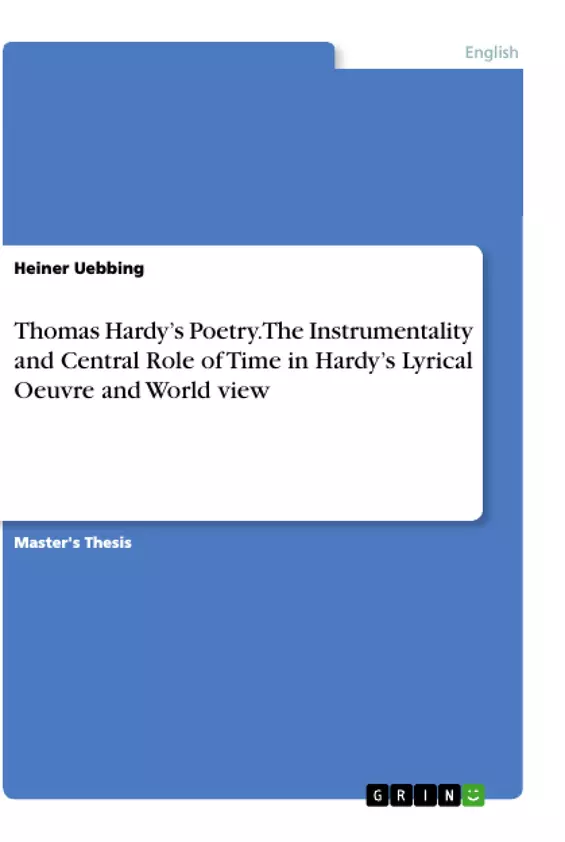The centrality of the entity of time in its various incarnations and occurrences is amongst the most prominent of Thomas Hardy's themes. The variety of Hardy’s output, in structure, rhyme, metre, and ideas render a concise and complete account of any subject or motif impractical. Nonetheless, the ubiquity and varied application of temporal concepts and notions allow for a categorisation of different occurrences of these temporal images and a consequent thorough analysis in terms of their connections and deviations, in order to be able to isolate overarching ideologies and their interplay within Hardy’s lyrics.
The three main frameworks for these uses of time discussed are the historical past, natural imagery, and Hardy's own concept of Evolutionary Meliorism. All these categories have overlapping and adjacent connotations. In order to frame the subjects in a clear and focussed way, their respective chapters all include analyses of two individual poems regarding their corresponding motif, while the discovered implications and insights are collated with previous scholarly assertions on Hardy’s poetry.
The Poems discussed within this thesis include: The Last Chrysanthemum, The Roman Road, Rome: On the Palatine, The Darkling Thrush, To Outer Nature and The Lacking Sense.
Inhaltsverzeichnis (Table of Contents)
- Introduction
- Lyrical Correspondence with the Historical Past
- The Roman Road
- Rome: On The Palantine
- Nature and Natural Imagery Conceptualised through Temporal Processes
- The Last Chrysanthemum
- The Darkling Thrush
- Evolutionary Meliorism
- The Concept of Evolutionary Meliorism
- To Outer Nature
- The Lacking Sense
- Conclusion
Zielsetzung und Themenschwerpunkte (Objectives and Key Themes)
This paper examines the central role of time in Thomas Hardy's lyrical oeuvre. It explores how Hardy utilizes time in its various manifestations and occurrences to express his ideas and worldview. The paper investigates three main frameworks for Hardy's uses of time: the historical past, natural imagery, and Evolutionary Meliorism.
- The Instrumentality and Central Role of Time in Hardy's Lyrical Oeuvre
- The Historical Past as a Source of Meaning and Connection
- Nature and Natural Imagery as Representations of Temporal Processes
- Evolutionary Meliorism as a Defining Worldview in Hardy's Poetry
- The Interplay of Time, Nature, and History in Shaping Hardy's Lyrical Vision
Zusammenfassung der Kapitel (Chapter Summaries)
The first chapter focuses on the historical past and its correspondence with Hardy's lyrical works. It analyzes two poems, "The Roman Road" and "Rome: On The Palantine", to demonstrate how Hardy uses the historical past to create meaningful connections and illuminate the concept of moments of vision.
The second chapter investigates the relationship between time and nature in Hardy's poetry. It examines "The Last Chrysanthemum" and "The Darkling Thrush" to illustrate how Hardy utilizes floral and faunal imagery to represent temporal processes and the concept of Mother Nature.
The third chapter delves into Hardy's self-defined worldview, Evolutionary Meliorism. It defines the term and explores its influence on two poems, "To Outer Nature" and "The Lacking Sense", analyzing how they incorporate and utilize the concepts of time, nature, and history within this framework.
Schlüsselwörter (Keywords)
Thomas Hardy, time, poetry, lyrical oeuvre, historical past, natural imagery, Evolutionary Meliorism, moments of vision, Mother Nature, temporal processes, worldview.
- Citation du texte
- Heiner Uebbing (Auteur), 2017, Thomas Hardy’s Poetry. The Instrumentality and Central Role of Time in Hardy’s Lyrical Oeuvre and World view, Munich, GRIN Verlag, https://www.grin.com/document/1142542



